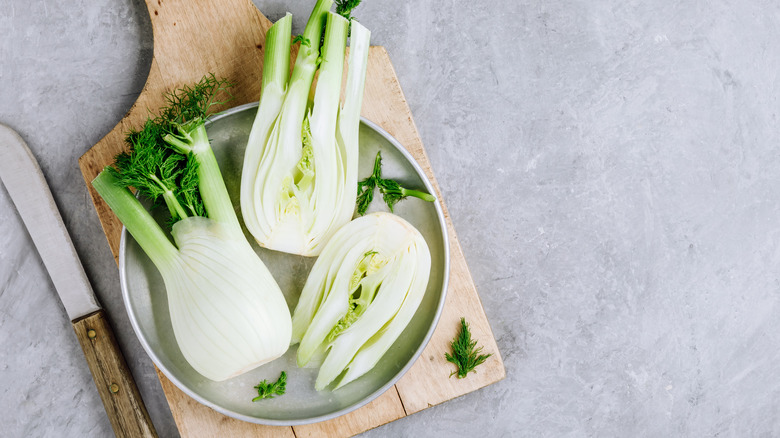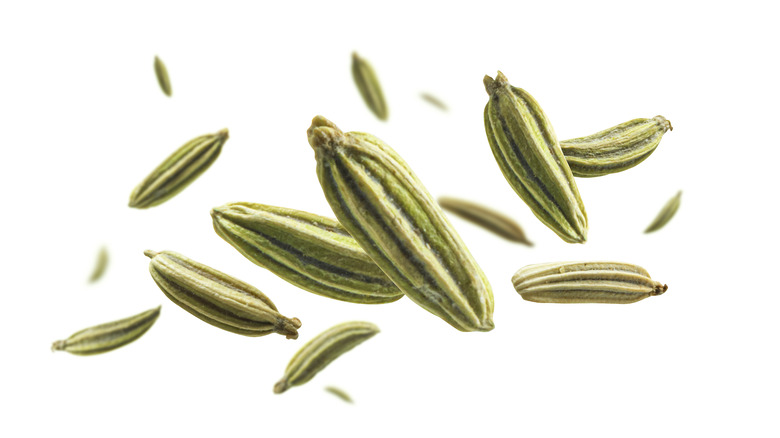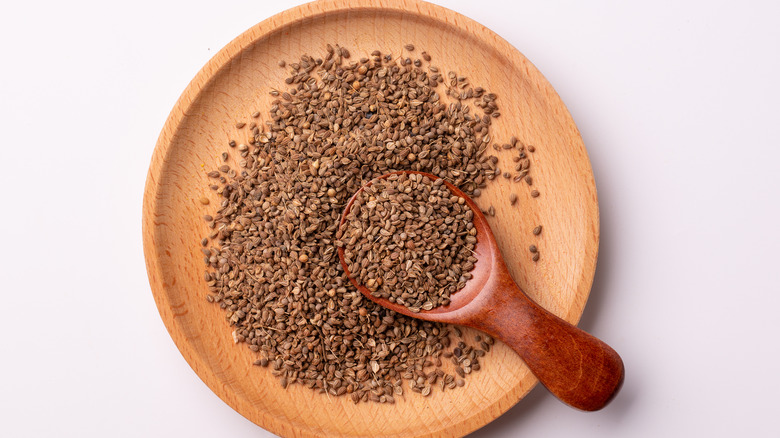What Are The Differences Between Anise And Fennel?
One of the more polarizing flavors, the licorice-y notes of fennel and anise tend to be either deeply cherished or entirely avoided. Most tend to conflate the two, though, referring to fennel and anise interchangeably. What exactly is the difference, if there is one at all? It gets a bit tricky, so buckle in.
If you've ever wondered what fennel is or what it tastes like, you're in for a treat, as it's not like other vegetables. Interestingly, Splendid Table notes that there's actually an incorrect nomenclature used in many grocery stores and regions because there is actually no such thing as an "anise bulb." Rest assured, any flowering bulb with dill-esque fronds is decidedly a fennel bulb, not anise. "Fennel" is used interchangeably to refer to the entirely edible bulb as well as the dried seed.
Moreover, Greatist notes that "the bulb, foliage, and seeds of the fennel plant are used." Conversely, the anise bush grows anise seeds specifically; nothing else on the plant is consumed or harvested aside from the seeds. Then, as Simply Recipes notes, anise is actually "in the same plant family as parsley, carrots, and celery," not fennel. Still, there are more differences than meets the eye.
Fennel and anise even grow differently
Gardening Know How clarifies that anise and fennel are actually entirely different, stating that "anise is an annual" while "fennel is a perennial." Their flavor is very similar, which is derived from an oil that is naturally occurring in both, but there are subtle differences between the two. Gardening Know How states that anise is more forward and aggressive in flavor, while fennel is a bit more subtle. According to Gardening Know How, both seeds are used in cooking, but fennel is best for savory preparations, while anise is best in sweets.
As one Redditor notes that fennel tends to be "woody" in flavor, a trait that anise doesn't share. Anise, on the other hand, is more of a warming spice that is sometimes used in conjunction with flavors such as cinnamon or nutmeg. In fact, anise is often used in Italian desserts, such as biscotti or pizzelle, as noted by Spiceography.
When it comes to savory applications, fennel is often used in Italian sausage and fish dishes and is sometimes simply roasted. Many Italian families also use fennel as a palate cleanser (via Doing Italy). Fennel is wonderful both cooked and raw, is incredibly versatile, and is generally an underrated and under-celebrated vegetable. If you're especially anti-licorice, don't fret; the flavor mellows out immensely once cooked, turning into a deeply caramelized, subtly flavored vegetable that pairs well with many proteins and other vegetables.
What are the similarities between anise and fennel?
Some also purchase powdered or pulverized versions of both spices for use in various recipes, dishes, and applications. In addition, both anise and fennel are used in liqueurs and teas, primarily due to their nutritional and health benefits. In fact, they're both helpful in aiding gastrointestinal issues (via Medical News Today, Healthline). Sometimes, anise can also veer into a spicy flavor, whereas fennel remains quite neutral, clean, and mild. Moreover, many relate star anise to anise, but it's actually from an entirely different plant altogether — and star anise looks and tastes different, too.
Generally, fennel and anise seeds can be used interchangeably, but it's important to note that they have many inherent differences. No matter which seed you're planning on using, though, toasting the spice prior to using it will help to elevate the flavor and help release some of the seeds' oils. Don't steer clear of both anise and fennel overall if you're not a licorice fan; both add a lovely, piquant flavor to both savory and sweet dishes. They should both be embraced and can be enjoyed to your taste when prepared correctly.


